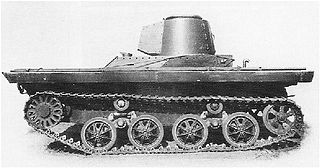
A tankette is a tracked armoured fighting vehicle that resembles a small tank, roughly the size of a car. It is mainly intended for light infantry support and scouting. Colloquially it may also simply mean a small tank.

The Vickers 6-Ton Tank or Vickers Mark E was a British light tank designed as a private project at Vickers. It was not purchased by the British Army, but was picked up by many foreign armed forces. It was licensed by the Soviets as the T-26. It was also the direct predecessor of the Polish 7TP tank.

The Type 94 tankette was a tankette used by the Imperial Japanese Army in the Second Sino-Japanese War, at Nomonhan against the Soviet Union, and in World War II. Although tankettes were often used as ammunition tractors, and general infantry support, they were designed for reconnaissance, and not for direct combat. The lightweight Type 94 proved effective in China as the Chinese National Revolutionary Army had only three tank battalions to oppose them, and those tank battalions were equipped only with some British export models and Italian CV-33 tankettes. As with nearly all tankettes built in the 1920s and 1930s, they had thin armor that could be penetrated by .50 caliber machine gun fire at 600 yards (550 m) range.

The Universal Carrier, also known as the Bren Gun Carrier and sometimes simply the Bren Carrier from the light machine gun armament, is a common name describing a family of light armoured tracked vehicles built by Vickers-Armstrongs and other companies.

The Light Tank Mark I to Mark V were a series of related designs of light tank produced by Vickers for the British Army during the interwar period.

The Carden Loyd tankettes were a series of British pre-World War II tankettes, the most successful of which was the Mark VI, the only version built in significant numbers. It became a classic tankette design worldwide, was licence-built by several countries and became the basis of several designs produced in various countries.

This article discusses tanks of the interwar period.

The T-37A was a Soviet amphibious light tank. The tank is often referred to as the T-37, although that designation was used by a different tank which never left the prototype stage. The T-37A was the first series of mass-produced fully amphibious tanks in the world.

The Imperial Japanese Army (IJA) initially purchased foreign tanks for evaluation during World War I, and began developing its own indigenous designs during the late 1920s.

Sir John Valentine Carden, 6th Baronet MBE was an English tank and vehicle designer. He was the sixth Baronet of Templemore, Tipperary, from 1931.
The Belgian Army had approximately 200 combat vehicles at the time of the German invasion in May 1940. The vehicles were distributed among infantry and cavalry divisions for use as support weapons. The Belgian Army viewed their combat vehicles as defensive weapons. The practice of spreading out combat vehicles in so called "penny packets" left them at a disadvantage against the German invaders, who concentrated their armour into organic units that could act on their own and that outnumbered the opposing vehicles even if units of the same type met.

A light tank is a tank variant initially designed for rapid movements in and out of combat, to harass and outmaneuver heavier tanks. It is smaller in size with thinner armor and less powerful main gun, tailored for better tactical mobility and ease of transport and logistics. They are primarily employed in the screening, armoured reconnaissance, skirmishing, artillery observation, and supplementing landing operations in a fire support role of expeditionary forces where larger, heavier tanks are unavailable or have difficulties operating safely or efficiently.

The Vickers T-15 light tank, full designation Char Léger de Reconnaissance Vickers-Carden-Loyd Mod.1934 T.15, was a light 4-ton tank of the Belgian Army. They were built by Vickers-Armstrong in the UK to the design of their Light Tank Mark III and outfitted with their armament in Belgium by Fonderie Royale de Canons (FRC) at Herstal. It entered service in 1935, and was used by the Belgian Army during the Battle of Belgium in May 1940. Its main armament was a 13.2 mm Hotchkiss machine gun. The tank was intended as a replacement for the venerable but obsolescent Renault FT. Only 42 were produced.

PZInż 130 was a prototype of Polish amphibious tank of the 1930s. Only a single prototype was built.
Captain Vivian Graham Loyd MC, was an English soldier and engineer who designed armoured vehicles including the Carden Loyd tankette and Loyd Carrier.
This page is based on this
Wikipedia article Text is available under the
CC BY-SA 4.0 license; additional terms may apply.
Images, videos and audio are available under their respective licenses.













